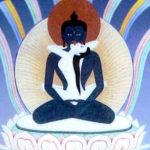
Samantabhadra. (T. Kun tu bzang po). The Sanskrit name of both an important bodhisattva in Indian and East Asian Buddhism and of an important buddha in Tibetan Buddhism… As a buddha, Samantabhadra is the primordial buddha (ĀDIBUDDHA) according to the RNYING MA sect of Tibetan Buddhism. He is depicted naked, blue, and in sexual union with his consort Samantabhadrī. He is embodiment of the original purity of all phenomena of SAṂSĀRA and NIRVĀṆA. Called the “primordial basis” (ye gzhi), he is regarded as the eternal union of awareness (RIG PA) and emptiness (ŚŪNYATĀ), of emptiness and appearance, and of the nature of the mind and compassion. As such he is the wellspring of the ATIYOGA teachings.
rig pa. The standard Tibetan translation of the Sanskrit term VIDYĀ, or “knowledge.” The Tibetan term, however, has a special meaning in the ATIYOGA and RDZOGS CHEN traditions of the RNYING MA sect of Tibetan Buddhism, where it refers to the most profound form of consciousness. Some modern translators of Tibetan texts into European languages consider the term too profound to be rendered into a foreign language, while others translate it as “awareness,” “pure awareness,” or “mind.” Unlike the “mind of clear light” (PRABHĀSVARACITTA; ’od gsal gyi sems) as described in other tantric systems, rig pa is not said to be accessible only in extraordinary states, such as death and sexual union; instead, it is fully present, although generally unrecognized, in each moment of sensory experience. Rig pa is described as the primordial basis, characterized with qualities such as presence, spontaneity, luminosity, original purity, unobstructed freedom, expanse, clarity, self-liberation, openness, effortlessness, and intrinsic awareness. It is not accessible through conceptual elaboration or logical analysis. Rather, rig pa is an eternally pure state free from the dualism of subject and object, infinite and complete from the beginning. It is regarded as the ground or the basis of both SAṂSĀRA and NIRVĀṆA, with the phenomena of the world being its reflection; all thoughts and all objects of knowledge are said to arise from rig pa and dissolve into rig pa. The ordinary mind believes that its own creations are real, forgetting its true nature of original purity. For the mind willfully to seek to liberate itself is both inappropriate and futile because rig pa is already self-liberated. Rig pa therefore is also the path, and its exponents teach practices that instruct the student how to distinguish rig pa from ordinary mental states. These practices include a variety of techniques designed to eliminate karmic obstacles (KARMĀVARAṆA), at which point the presence of rig pa in ordinary experience is introduced, allowing the mind to eliminate all thoughts and experiences itself, thereby recognizing its true nature. Rig pa is thus also the goal of the path, the fundamental state that is free from obscuration.
Guhyagarbhatantra. (Tibetan: Gsang ba’i snying po’i rgyud). In Sanskrit, the “Secret Essence Tantra,” a central text of the RNYING MA sect of Tibetan Buddhism and the RDZOGS CHEN (i.e. Dzogchen) tradition. The tantra is regarded as an expression of the enlightened intention of the primordial DHARMAKĀYA, the buddha SAMANTABHADRA. It is a work of Indic origin, appearing around mid-eighth century, probably after the GUHYASAMĀJATANTRA. It is unclear whether the text was called Guhyagarbha at the time of its composition or whether that title was added later. In DUNHUANG documents, it is usually referred to as the Māyājālatantra. By the time of a late tenth-century manuscript, it is called the Guhyagarbhatantra. The later Tibetan tradition identifies the Guhyagarbha as the root tantra of the MAHĀYOGA class, as well as the main tantra of the MĀYĀJĀLA cycle of tantras, a group of eighteen mahāyoga tantras. The Guhyagarbha was particularly influential in late eighth- and early ninth-century Tibet, when it was a principal inspiration for the early rdzogs chen movement. Its Māyājāla MAṆḌALA of one hundred deities (forty-two peaceful and fifty-eight wrathful) was widely employed…
Buswell Jr., Robert E.; Donald S., Jr. Lopez. The Princeton Dictionary of Buddhism. Princeton University Press.


… As a bodhisattva, Samantabhadra is a principal bodhisattva of the MAHĀYĀNA pantheon, who is often portrayed as the personification of the perfection of myriad good works and spiritual practices. He is one of the AṢṬAMAHOPAPUTRA, and an attendant of ŚĀKYAMUNI Buddha, standing opposite MAÑJUŚRĪ at the Buddha’s side. In the PAÑCATATHĀGATA configuration, he is associated with the buddha VAIROCANA. Samantabhadra figures prominently in the AVATAṂSAKASŪTRA. In a chapter named after him, he sets forth ten SAMĀDHIs. In the GAṆḌAVYŪHA (the final chapter of the Avataṃsakasūtra), the bodhisattva SUDHANA sets out in search of a teacher, encountering fifty-two beings (twenty of whom are female), including the Buddha’s mother Mahāmāyā (MĀYĀ), the future buddha MAITREYA, as well as AVALOKITEŚVARA and MAÑJUŚRĪ. His final teacher is the bodhisattva Samantabhadra, who sets forth the ten vows in his famous BHADRACARĪPRAṆIDHĀNA…
Compare ‘rig pa’ with Greek ‘gnosis’:
https://en.wikipedia.org/wiki/Gnosis